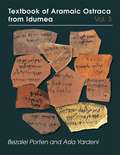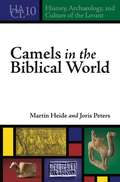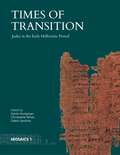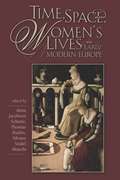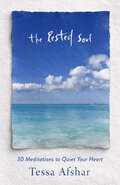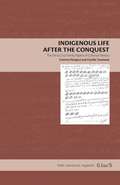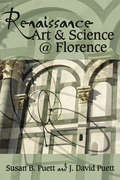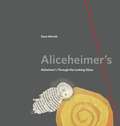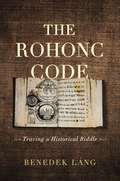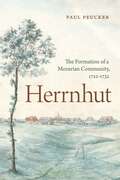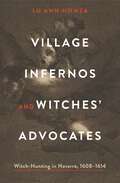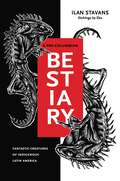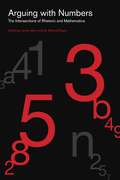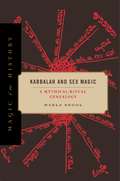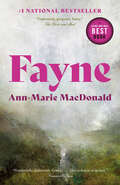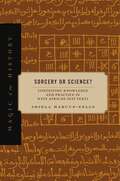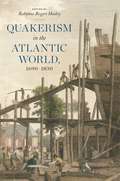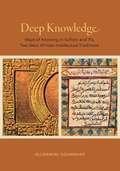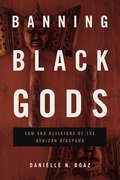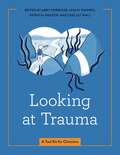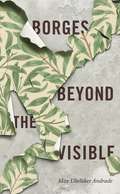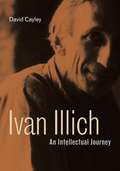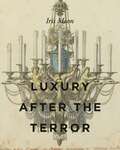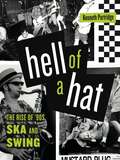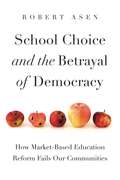- Table View
- List View
Textbook of Aramaic Ostraca from Idumea, Volume 3: 401 Commodity Chits
by Bezalel Porten Ada YardeniSince the early 1990s, about two thousand Idumean Aramaic ostraca have found their way into museums, libraries, and private collections. Four major publications covering some of these texts have appeared, three of which encompass the ostraca held by individual collectors only. This multivolume work classifies the ostraca according to subject matter and brings them together in a single publication. Volumes 1 and 2 covered fifty personal name dossiers (TAO A1-50). Volume 3 contains more than two hundred more such dossiers (TAO A51-255a) and numerous fragments. Each text is accompanied by a color photograph and hand-copy, a facing transcription and translation, and a ceramic description and commentary. The translation uniquely provides marginal captions identifying the phrases. In addition to the presentation of individual texts, there are six dossiers of tables covering all the commodity chits, parallel tables that classify them according to month or size, and comparative lists of entries.Textbook of Aramaic Ostraca from Idumea is a unique source for the onomastics and the social and economic history of fourth-century Idumea and, by extension, Judah (Yehud).
Camels in the Biblical World (History, Archaeology, and Culture of the Levant)
by Martin Heide Joris PetersCamels are first mentioned in the Bible as the movable property of Abraham. During the early monarchy, they feature prominently as long-distance mounts for the Queen of Sheba, and almost a millennium later, the Gospels tell us about the impossibility of a camel passing through a needle’s eye. Given the limited extrabiblical evidence for camels before circa 1000 BCE, a thorough investigation of the spatio-temporal history of the camel in the ancient Near and Middle East is necessary to understand their early appearance in the Hebrew Bible.Camels in the Biblical World is a two-part study that charts the cultural trajectories of two domestic species—the two-humped or Bactrian camel (Camelus bactrianus) and the one-humped or Arabian camel (Camelus dromedarius)—from the fourth through first millennium BCE and up to the first century CE. Drawing on archaeological camel remains, iconography, inscriptions, and other text sources, the first part reappraises the published data on the species’ domestication and early exploitation in their respective regions of origin. The second part takes a critical look at the various references to camels in the Hebrew Bible and the Gospels, providing a detailed philological analysis of each text and referring to archaeological data and zoological observations whenever appropriate. A state-of-the-art evaluation of the cultural history of the camel and its role in the biblical world, this volume brings the humanities into dialogue with the natural sciences. The novel insights here serve scholars in disciplines as diverse as biblical studies, (zoo)archaeology, history, and philology.
Times of Transition: Judea in the Early Hellenistic Period (Mosaics: Studies on Ancient Israel #1)
by Sylvie honigman, Christophe Nihan and Oded LipschitsThis multidisciplinary study takes a fresh look at Judean history and biblical literature in the late fourth and third centuries BCE. In a major reappraisal of this era, the contributions to this volume depict it as one in which critical changes took place.Until recently, the period from Alexander’s conquest in 332 BCE to the early years of Seleucid domination following Antiochus III’s conquest in 198 BCE was reputed to be poorly documented in material evidence and textual production, buttressing the view that the era from late Persian to Hasmonean times was one of seamless continuity. Biblical scholars believed that no literary activity belonged to the Hellenistic age, and archaeologists were unable to refine their understanding because of a lack of secure chronological markers. However, recent studies are revealing this period as one of major social changes and intense literary activity. Historians have shed new light on the nature of the Hellenistic empires and the relationship between the central power and local entities in ancient imperial settings, and the redating of several biblical texts to the third century BCE challenges the traditional periodization of Judean history.Bringing together Hellenistic history, the archaeology of Judea, and biblical studies, this volume appraises the early Hellenistic period anew as a time of great transition and change and situates Judea within its broader regional and transregional imperial contexts.
Time, Space, and Women’s Lives in Early Modern Europe (Sixteenth Century Essays & Studies #57)
by Anne Jacobson SchutteThis collection offers a variety of approaches to aspects of women’s lives. It moves beyond men’s prescriptive pronouncements about female nature to women's lived experiences, replacing the singular woman with plural women and illuminating female agency. The contributors show that women’s lives changed over the life course and differed according to region and social class. They also demonstrate that in the early modern period the largely private spaces in women’s lives were not enclosed worlds isolated from the public spaces in which men operated.Contributors to this important collection are leading international scholars and offer strong, substantial, and archival-based research.
The Rested Soul: 30 Meditations to Quiet Your Heart
by Tessa AfsharTrue shalom for an anxiety-ridden world. Do you feel rested and at peace? Or are you bombarded with obstacles keeping you from true soul rest? Daily life can be a grind, full of confusion and chaos. Award-winning author and Bible teacher Tessa Afshar has been there. Drawing from the lessons she learned from battling anxiety in her own life, Tessa brings you on a journey that cultivates a rested soul. A book of 30 devotionals, The Rested Soul, includes vulnerable stories from Tessa&’s personal life—stories that will make you feel known and remind you that you are not alone. Full of inspiration found in ordinary moments, Tessa shows you how to remove the impediments that stand in the way of a quiet heart. These deep reflections are accompanied by beautiful images (photography by Tessa&’s husband). Exhale, heal, and find rest in God. Tessa&’s meditations create an oasis of calm when powerful storms of anxiety assail you. She brings you into your hope-filled, joy-infused life in Jesus. In Him, our hearts find quiet and comfort. In Him, we have favor, authority, and strength. In Jesus, we find The Rested Soul.
Indigenous Life After the Conquest: The De la Cruz Family Papers of Colonial Mexico (Latin American Originals)
by Caterina Pizzigoni Camilla TownsendThis book presents a unique set of written records belonging to the De la Cruz family, caciques of Tepemaxalco in the Toluca Valley. Composed in Nahuatl and Spanish and available here both in the original languages and in English translation, this collection of documents opens a window onto the life of a family from colonial Mexico’s indigenous elite and sheds light on the broader indigenous world within the Spanish colonial system.The main text is a record created in 1647 by long-serving governor don Pedro de la Cruz and continued by his heirs through the nineteenth century, along with two wills and several other notable documents. These sources document a community history, illuminating broader issues centering on politics, religion, and economics as well as providing unusual insight into the concerns and values of indigenous leaders. These texts detail the projects financed by the De la Cruz family, how they talked about them, and which belongings they deemed important enough to pass along after their death. Designed for classroom use, this clear and concise primary source includes a wealth of details about indigenous everyday life and preserves and makes accessible a rich and precious heritage. The engaging introduction highlights issues of class relations and the public and performative character of Nahua Christianity. The authors provide the necessary tools to help students understand the colonial context in which these documents were produced.
Renaissance Art & Science @ Florence (Early Modern Studies #17)
by Susan B. Puett J. David PuettThe creativity of the human mind was brilliantly displayed during the Florentine Renaissance when artists, mathematicians, astronomers, apothecaries, architects, and others embraced the interconnectedness of their disciplines. Artists used mathematical perspective in painting and scientific techniques to create new materials; hospitals used art to invigorate the soul; apothecaries prepared and dispensed, often from the same plants, both medicinals for patients and pigments for painters; utilitarian glassware and maps became objects to be admired for their beauty; art enhanced depictions of scientific observations; and innovations in construction made buildings canvases for artistic grandeur. An exploration of these and other intersections of art and science deepens our appreciation of the magnificent contributions of the extraordinary Florentines.
Aliceheimer’s: Alzheimer’s Through the Looking Glass (Graphic Medicine)
by Dana Walrath“Alice was always beautiful—Armenian immigrant beautiful, with thick, curly black hair, olive skin, and big dark eyes,” writes Dana Walrath. Alice also has Alzheimer’s, and while she can remember all the songs from The Music Man, she can no longer attend to the basics of caring for herself. Alice moves to live with her daughter, Dana, in Vermont, and the story begins. Aliceheimer’s is a series of illustrated vignettes, daily glimpses into their world with Alzheimer’s. Walrath’s time with her mother was marked by humor and clarity: “With a community of help that included pirates, good neighbors, a cast of characters from space-time travel, and my dead father hovering in the branches of the maple trees that surround our Vermont farmhouse, Aliceheimer’s let us write our own story daily—a story that, in turn, helps rewrite the dominant medical narrative of aging.” In drawing Alice, Walrath literally enrobes her with cut-up pages from Alice’s Adventures in Wonderland. She weaves elements from Lewis Carroll’s classic throughout her text, using evocative phrases from the novel to introduce the vignettes, such as “Disappearing Alice,” “Missing Pieces,” “Falling Slowly,” “Curiouser and Curiouser,” and “A Mad Tea Party.” Walrath writes that creating this book allowed her not only to process her grief over her mother’s dementia, but also “to remember the magic laughter of that time.” Graphic medicine, she writes, “lets us better understand those who are hurting, feel their stories, and redraw and renegotiate those social boundaries. Most of all, it gives us a way to heal and to fly over the world as Alice does.” In the end, Aliceheimer’s is indeed strangely and utterly uplifting.
The Rohonc Code: Tracing a Historical Riddle
by Benedek LángFirst discovered in a Hungarian library in 1838, the Rohonc Codex keeps privileged company with some of the most famous unsolved writing systems in the world, notably the Voynich manuscript, the Phaistos Disk, and Linear A. Written entirely in cipher, this 400-year-old, 450-page-long, richly illustrated manuscript initially gained considerable attention but was later dismissed as an apparent forgery. No serious scholar would study it again until the turn of the twenty-first century. This engaging narrative follows historian Benedek Láng’s search to uncover the truth about this thoroughly mysterious book that has puzzled dozens of codebreakers. Láng surveys the fascinating theories associated with the Codex and discusses possible interpretations of the manuscript as a biblical commentary, an apocryphal gospel, or a secret book written for and by a sect. He provides an overview of the secret writing systems known in early modern times and an account of the numerous efforts to create an artificial language or to find a long-lost perfect tongue—endeavors that were especially popular at the time the Codex was made. Lastly, he tests several codebreaking methods in order to decipher the Codex, finally pointing to a possible solution to the enigma of its content and language system.Engagingly written, academically grounded, and thoroughly compelling, The Rohonc Code will appeal to historians, scholars, and lay readers interested in mysteries, codes, and ciphers.
Herrnhut: The Formation of a Moravian Community, 1722–1732 (Pietist, Moravian, and Anabaptist Studies)
by Paul PeuckerIn June 1722, three families from Moravia settled on the estate of Count Nikolaus Ludwig von Zinzendorf in Berthelsdorf, Saxony. Known as the community of Herrnhut, their settlement quickly grew to become the epicenter of a transatlantic religious movement, one that would attract thousands of Europeans, American Indians, and enslaved Africans: the Moravian Church.Written by one of the leading archivists of the Moravian Church, this book investigates the origins of Herrnhut. Paul Peucker argues that Herrnhut was intended to be a Philadelphian community, uniting “true Christians” from all denominations. It was a separatist movement, but it concealed its separatism behind the pretense of an affiliation with the Lutheran Church and behind a chosen historical identity, that of the renewed Unity of Brethren. Peucker’s analysis, based on hundreds of documents from archives in Germany and the United States, demonstrates how Herrnhut was able to grow and thrive despite existing regulations against new religious groups, uncovers Count Zinzendorf’s role in keeping Herrnhut outside the state church, and provides a new foundation from which to interpret the Moravian church’s later years.Three centuries after Herrnhut’s founding, this intriguing history brings to light new information about the early years of the Moravian church. Peucker’s work will be especially valuable to students and scholars of eighteenth-century religion, Pietism, and Moravian history.
Village Infernos and Witches’ Advocates: Witch-Hunting in Navarre, 1608–1614 (Iberian Encounter and Exchange, 475–1755)
by Lu Ann HomzaThis book revises what we thought we knew about one of the most famous witch hunts in European history. Between 1608 and 1614, thousands of witchcraft accusations were leveled against men, women, and children in the northern Spanish kingdom of Navarre. The Inquisition intervened quickly but incompetently, and the denunciations continued to accelerate. As the phenomenon spread, children began to play a crucial role. Not only were they reportedly victims of the witches’ harmful magic, but hundreds of them also insisted that witches were taking them to the Devil’s gatherings against their will. Presenting important archival discoveries, Lu Ann Homza restores the perspectives of illiterate, Basque-speaking individuals to the history of this shocking event and demonstrates what could happen when the Spanish Inquisition tried to take charge of a liminal space. Because the Spanish Inquisition was the body putting those accused of witchcraft on trial, modern scholars have depended upon Inquisition sources for their research. Homza’s groundbreaking book combines new readings of the Inquisitional evidence with fresh archival finds from non-Inquisitional sources, including local secular and religious courts, and from notarial and census records. Expanding our understanding of this witch hunt as well as the history of children, community norms, and legal expertise in early modern Europe, Village Infernos and Witches’ Advocates is required reading for students and scholars of the Spanish Inquisition and the history of witchcraft in early modern Europe.
A Pre-Columbian Bestiary: Fantastic Creatures of Indigenous Latin America
by Ilan StavansAn encyclopedic collaboration between award-winning Mexican American scholar Ilan Stavans and illustrator Eko, A Pre-Columbian Bestiary features lively and informative descriptions of forty-six religious, mythical, and imaginary creatures from the Nahua, Aztec, Maya, Tabasco, Inca, Aymara, and other cultures of Latin America.From the siren-like Acuecuéyotl and the water animal Chaac to the class-conscious Oc and the god of light and darkness Xólotl, the magnificent entities in this volume belong to the same family of real and invented creatures imagined by Dante, Franz Kafka, C. S. Lewis, Jorge Luis Borges, Umberto Eco, and J. K. Rowling. They are mined from indigenous religious texts, like the Popol Vuh, and from chronicles, both real and fictional, of the Spanish conquest by Diego Durán, Bernal Díaz del Castillo, and Fernando de Zarzamora, among others. In this playful compilation, Stavans distills imagery from the work of magic realist masters such as Juan Rulfo and Gabriel García Márquez; from songs of protest in Mexico, Guatemala, and Peru; and from aboriginal beasts in Jewish, Muslim, European, British, and other traditions. In the spirit of imaginative invention, even the bibliography is a mixture of authentic and concocted material.An inspiring record of resistance and memory from a civilization whose superb pantheon of myths never ceases to amaze, A Pre-Columbian Bestiary will delight anyone interested in the history and culture of Latin America.
Arguing with Numbers: The Intersections of Rhetoric and Mathematics (RSA Series in Transdisciplinary Rhetoric)
by James Wynn G. Mitchell ReyesAs discrete fields of inquiry, rhetoric and mathematics have long been considered antithetical to each other. That is, if mathematics explains or describes the phenomena it studies with certainty, persuasion is not needed. This volume calls into question the view that mathematics is free of rhetoric. Through nine studies of the intersections between these two disciplines, Arguing with Numbers shows that mathematics is in fact deeply rhetorical. Using rhetoric as a lens to analyze mathematically based arguments in public policy, political and economic theory, and even literature, the essays in this volume reveal how mathematics influences the values and beliefs with which we assess the world and make decisions and how our worldviews influence the kinds of mathematical instruments we construct and accept. In addition, contributors examine how concepts of rhetoric—such as analogy and visuality—have been employed in mathematical and scientific reasoning, including in the theorems of mathematical physicists and the geometrical diagramming of natural scientists. Challenging academic orthodoxy, these scholars reject a math-equals-truth reduction in favor of a more constructivist theory of mathematics as dynamic, evolving, and powerfully persuasive. By bringing these disparate lines of inquiry into conversation with one another, Arguing with Numbers provides inspiration to students, established scholars, and anyone inside or outside rhetorical studies who might be interested in exploring the intersections between the two disciplines.In addition to the editors, the contributors to this volume are Catherine Chaput, Crystal Broch Colombini, Nathan Crick, Michael Dreher, Jeanne Fahnestock, Andrew C. Jones, Joseph Little, and Edward Schiappa.
Kabbalah and Sex Magic: A Mythical-Ritual Genealogy (Magic in History)
by Marla SegolIn this provocative book, Marla Segol explores the development of the kabbalistic cosmology underlying Western sex magic. Drawing extensively on Jewish myth and ritual, Segol tells the powerful story of the relationship between the divine and the human body in late antique Jewish esotericism, in medieval kabbalah, and in New Age ritual practice.Kabbalah and Sex Magic traces the evolution of a Hebrew microcosm that models the powerful interaction of human and divine bodies at the heart of both kabbalah and some forms of Western sex magic. Focusing on Jewish esoteric and medical sources from the fifth to the twelfth century from Byzantium, Persia, Iberia, and southern France, Segol argues that in its fully developed medieval form, kabbalah operated by ritualizing a mythos of divine creation by means of sexual reproduction. She situates in cultural and historical context the emergence of Jewish cosmological models for conceptualizing both human and divine bodies and the interactions between them, arguing that all these sources position the body and its senses as the locus of culture and the means of reproducing it. Segol explores the rituals acting on these models, attending especially to their inherent erotic power, and ties these to contemporary Western sex magic, showing that such rituals have a continuing life. Asking questions about its cosmology, myths, and rituals, Segol poses even larger questions about the history of kabbalah, the changing conceptions of the human relation to the divine, and even the nature of religious innovation itself. This groundbreaking book will appeal to students and scholars of Jewish studies, religion, sexuality, and magic.
Fayne: A Novel
by Ann-Marie MacDonaldTHE INSTANT #1 NATIONAL BESTSELLERWINNER OF THE 2023 PARAGRAPHE HUGH MACLENNAN PRIZE FOR FICTIONA GLOBE AND MAIL BEST BOOK OF THE YEARONE OF CBC&’S BEST CANADIAN FICTION BOOKS OF 2022A beloved writer returns with a tale of science, magic, love and identity.In the late nineteenth century, Charlotte Bell is growing up at Fayne, a vast and lonely estate straddling the border between England and Scotland, where she has been kept from the world by her adoring father, Lord Henry Bell, owing to a mysterious condition. Charlotte, strong and insatiably curious, revels in the moorlands, and has learned the treacherous and healing ways of the bog from the old hired man, Byrn, whose own origins are shrouded in mystery. Her idyllic existence is shadowed by the magnificent portrait on the landing in Fayne House which depicts her mother, a beautiful Irish-American heiress, holding Charlotte&’s brother, Charles Bell. Charlotte has grown up with the knowledge that her mother died in giving birth to her, and that her older brother, Charles, the long-awaited heir, died soon afterwards at the age of two. When Charlotte&’s appetite for learning threatens to exceed the bounds of the estate, her father breaks with tradition and hires a tutor to teach his daughter &“as you would my son, had I one.&” But when Charlotte and her tutor&’s explorations of the bog turn up an unexpected artefact, her father announces he has arranged for her to be cured of her condition, and her world is upended. Charlotte&’s passion for knowledge and adventure will take her to the bottom of family secrets and to the heart of her own identity.
Sorcery or Science?: Contesting Knowledge and Practice in West African Sufi Texts (Magic in History)
by Ariela Marcus-SellsSorcery or Science? examines how two Sufi Muslim theologians who rose to prominence in the western Sahara Desert in the late eighteenth century, Sīdi al-Mukhtār al-Kuntī (d. 1811) and his son and successor, Sīdi Muḥammad al-Kuntī (d. 1826), decisively influenced the development of Sufi Muslim thought in West Africa.Known as the Kunta scholars, Mukhtār al-Kuntī and Muḥammad al-Kuntī were influential teachers who developed a pedagogical network of students across the Sahara. In exploring their understanding of “the realm of the unseen”—a vast, invisible world that is both surrounded and interpenetrated by the visible world—Ariela Marcus-Sells reveals how these theologians developed a set of practices that depended on knowledge of this unseen world and that allowed practitioners to manipulate the visible and invisible realms. They called these practices “the sciences of the unseen.” While they acknowledged that some Muslims—particularly self-identified “white” Muslim elites—might consider these practices to be “sorcery,” the Kunta scholars argued that these were legitimate Islamic practices. Marcus-Sells situates their ideas and beliefs within the historical and cultural context of the Sahara Desert, surveying the cosmology and metaphysics of the realm of the unseen and the history of magical discourses within the Hellenistic and Arabo-Islamic worlds. Erudite and innovative, this volume connects the Islamic sciences of the unseen with the reception of Hellenistic discourses of magic and proposes a new methodology for reading written devotional aids in historical context. It will be welcomed by scholars of magic and specialists in Africana religious studies, Islamic occultism, and Islamic manuscript culture.
Quakerism in the Atlantic World, 1690–1830 (The New History of Quakerism)
by Robynne Rogers HealeyThis third installment in the New History of Quakerism series is a comprehensive assessment of transatlantic Quakerism across the long eighteenth century, a period during which Quakers became increasingly sectarian even as they expanded their engagement with politics, trade, industry, and science. The contributors to this volume interrogate and deconstruct this paradox, complicating traditional interpretations of what has been termed “Quietist Quakerism.”Examining the period following the Toleration Act in England of 1689 through the Hicksite-Orthodox Separation in North America, this work situates Quakers in the eighteenth-century British Atlantic world. Three thematic sections—exploring unique Quaker testimonies and practices; tensions between Quakerism in community and Quakerism in the world; and expressions of Quakerism around the Atlantic world—broaden geographic understandings of the Quaker Atlantic experience to determine how local events shaped expressions of Quakerism. The authors challenge oversimplified interpretations of Quaker practices and reveal a complex Quaker world, one in which prescription and practice were more often negotiated than dictated, even after the mid-eighteenth-century “reformation” and tightening of the Discipline on both sides of the Atlantic. Accessible and well-researched, Quakerism in the Atlantic World, 1690-1830, provides fresh insights and raises new questions about an understudied period of Quaker history.In addition to the editor, the contributors to this volume include Richard C. Allen, Erin Bell, Erica Canela, Elizabeth Cazden, Andrew Fincham, Sydney Harker, Rosalind Johnson, Emma Lapsansky-Werner, Jon Mitchell, and Geoffrey Plank.
Deep Knowledge: Ways of Knowing in Sufism and Ifa, Two West African Intellectual Traditions (Africana Religions)
by Oludamini OgunnaikeThis book is an in-depth, comparative study of two of the most popular and influential intellectual and spiritual traditions of West Africa: Tijani Sufism and Ifa. Employing a unique methodological approach that thinks with and from—rather than merely about—these traditions, Oludamini Ogunnaike argues that they contain sophisticated epistemologies that provide practitioners with a comprehensive worldview and a way of crafting a meaningful life.Using theories belonging to the traditions themselves as well as contemporary oral and textual sources, Ogunnaike examines how both Sufism and Ifa answer the questions of what knowledge is, how it is acquired, and how it is verified. Or, more simply: What do you know? How did you come to know it? How do you know that you know? After analyzing Ifa and Sufism separately and on their own terms, the book compares them to each other and to certain features of academic theories of knowledge. By analyzing Sufism from the perspective of Ifa, Ifa from the perspective of Sufism, and the contemporary academy from the perspective of both, this book invites scholars to inhabit these seemingly “foreign” intellectual traditions as valid and viable perspectives on knowledge, metaphysics, psychology, and ritual practice.Unprecedented and innovative, Deep Knowledge makes a significant contribution to cross-cultural philosophy, African philosophy, religious studies, and Islamic studies. Its singular approach advances our understanding of the philosophical bases underlying these two African traditions and lays the groundwork for future study.
Banning Black Gods: Law and Religions of the African Diaspora (Africana Religions)
by Danielle N. BoazBanning Black Gods is a global examination of the legal challenges faced by adherents of the most widely practiced African-derived religions in the twenty-first century, including Santeria/Lucumi, Haitian Vodou, Candomblé, Palo Mayombe, Umbanda, Islam, Rastafari, Obeah, and Voodoo. Examining court cases, laws, human rights reports, and related materials, Danielle N. Boaz argues that restrictions on African diaspora religious freedom constitute a unique and pervasive form of anti-Black discrimination.Emphasizing that these twenty-first-century cases and controversies are not a new phenomenon but rather a reemergence of colonial-era ideologies and patterns of racially motivated persecution, Boaz focuses each chapter on a particular challenge to Black religious freedom. She examines issues such as violence against devotees, restrictions on the ritual slaughter of animals, limitations on the custodial rights of parents, and judicial refusals to recognize these faiths as protected religions. Boaz introduces new issues that have never been considered as a question of religious freedom before—such as the right of Palo Mayombe devotees to possess remains of the dead—and she brings together controversies that have not been previously regarded as analogous, such as the right to wear headscarves and the right to wear dreadlocks in schools. Framing these issues in comparative perspective and focusing on transnational and transregional issues, Boaz advances our understanding of the larger human rights disputes that country-specific studies can overlook.Original and compelling, this important new book will be welcomed by students and scholars of African diaspora religions and discerning readers interested in learning more about the history of racial discrimination
Looking at Trauma: A Tool Kit for Clinicians (Graphic Medicine)
by Abby Hershler, Lesley Hughes, Patricia Nguyen, Shelley WallLooking at Trauma: A Tool Kit for Clinicians is an easy-to-use, engaging resource designed to address the challenges health care professionals face in providing much-needed trauma psychoeducation to clients with histories of childhood trauma. Developed by trauma therapists Abby Hershler and Lesley Hughes in collaboration with artist Patricia Nguyen and biomedical communications specialist Shelley Wall, this book presents twelve trauma treatment models accompanied by innovative and engaging comics. The models help clinicians provide practical information about the impacts of trauma to their clients—and support those clients in understanding and managing their distressing symptoms.Topics covered include complex posttraumatic stress disorder, emotion regulation, memory, relationship patterns, and self-care. Each chapter features step-by-step instructions on how to use the treatment models with clients; practical educational tips from experienced clinicians in the field of childhood trauma; interactive trauma education comics; a foundational framework focused on care for the provider; and references for further study.Intended for use in therapeutic, clinical, and classroom settings, this book is a valuable resource for all healthcare workers. In particular, social workers, psychotherapists, spiritual care providers, nurses, occupational therapists, psychologists, primary care physicians, and psychiatrists will find this tool kit indispensable.
Borges Beyond the Visible
by Max Ubelaker AndradeBorges Beyond the Visible presents radically new readings of some of Jorge Luis Borges’s most celebrated stories. Max Ubelaker Andrade shows how Borges employed intertextual puzzles to transform his personal experiences with blindness, sexuality, and suicide while allowing readers to sense the transformative power of their own literary imaginations.In readings of “Tlön, Uqbar, Orbis Tertius,” “El Aleph,” and “El Zahir,” Ubelaker Andrade argues that Borges, considering his own impending blindness, borrowed from Islam’s prohibitions on visual representation to create a “literary theology”—a religion focused on the contradictions of literary existence and the unstable complexities of a visual world perceived without everyday sight. Embracing these contradictions allowed Borges to transform his relationships with sex, sexuality, and family in multilayered stories such as “Emma Zunz,” “La intrusa,” and “El jardín de senderos que se bifurcan.” Yet these liberating transformations, sometimes offered to the reader as a paradoxical “gift of death,” are complicated by “La salvación por las obras,” a story built around Borges’s relationship with a suicidal reader and the woman to whom they were both connected. The epilogue presents “Místicos del Islam,” an unpublished essay draft by Borges, as a key source of insight into an irreverent, iconoclastic writing practice based on a profound faith in fiction.Compelling and clear, Borges Beyond the Visible is a revelatory examination of the work of one of the most influential authors of the twentieth century. It opens up exciting areas of inquiry for scholars, students, and readers of Borges.
Ivan Illich: An Intellectual Journey (Ivan Illich #2)
by David CayleyIn the eighteen years since Ivan Illich’s death, David Cayley has been reflecting on the meaning of his friend and teacher’s life and work. Now, in Ivan Illich: An Intellectual Journey, he presents Illich’s body of thought, locating it in its own time and retrieving its relevance for ours.Ivan Illich (1926–2002) was a revolutionary figure in the Roman Catholic Church and in the wider field of cultural criticism that began to take shape in the 1960s. His advocacy of a new, de-clericalized church and his opposition to American missionary programs in Latin America, which he saw as reactionary and imperialist, brought him into conflict with the Vatican and led him to withdraw from direct service to the church in 1969. His institutional critiques of the 1970s, from Deschooling Society to Medical Nemesis, promoted what he called institutional or cultural revolution. The last twenty years of his life were occupied with developing his theory of modernity as an extension of church history. Ranging over every phase of Illich’s career and meditating on each of his books, Cayley finds Illich to be as relevant today as ever and more likely to be understood, now that the many convergent crises he foresaw are in full public view and the church that rejected him is paralyzed in its “folkloric” shell.Not a conventional biography, though attentive to how Illich lived, Cayley’s book is “continuing a conversation” with Illich that will engage anyone who is interested in theology, philosophy, history, and the Catholic Church.
Luxury After the Terror
by Iris MoonWhen Louis XVI was guillotined on January 21, 1793, vast networks of production that had provided splendor and sophistication to the royal court were severed. Although the king’s royal possessions—from drapery and tableware to clocks and furniture suites—were scattered and destroyed, many of the artists who made them found ways to survive. This book explores the fabrication, circulation, and survival of French luxury after the death of the king.Spanning the final years of the ancien régime from the 1790s to the first two decades of the nineteenth century, this richly illustrated book positions luxury within the turbulent politics of dispersal, disinheritance, and dispossession. Exploring exceptional works created from silver, silk, wood, and porcelain as well as unrealized architectural projects, Iris Moon presents new perspectives on the changing meanings of luxury in the revolutionary and Napoleonic periods, a time when artists were forced into hiding, exile, or emigration. Moon draws on her expertise as a curator to revise conventional accounts of the so-called Louis XVI style, arguing that it was only after the revolutionary auctions liquidated the king’s collections that their provenance accrued deeper cultural meanings as objects with both a royal imprimatur and a threatening reactionary potential.Lively and accessible, this thought-provoking study will be of interest to curators, art historians, scholars, and students of the decorative arts as well as specialists in the French Revolution.
Hell of a Hat: The Rise of ’90s Ska and Swing (American Music History)
by Kenneth PartridgeIn the late ’90s, third-wave ska broke across the American alternative music scene like a tsunami. In sweaty clubs across the nation, kids danced themselves dehydrated to the peppy rhythms and punchy horns of bands like The Mighty Mighty Bosstones and Reel Big Fish. As ska caught fire, a swing revival brought even more sharp-dressed, brass-packing bands to national attention. Hell of a Hat dives deep into this unique musical moment. Prior to invading the Billboard charts and MTV, ska thrived from Orange County, California, to NYC, where Moon Ska Records had eager rude girls and boys snapping up every release. On the swing tip, retro pioneers like Royal Crown Revue had fans doing the jump, jive, and wail long before The Brian Setzer Orchestra resurrected the Louis Prima joint. Drawing on interviews with heavyweights like the Bosstones, Sublime, Less Than Jake, and Cherry Poppin' Daddies—as well as underground heroes like Mustard Plug, The Slackers, Hepcat, and The New Morty Show—Kenneth Partridge argues that the relative economic prosperity and general optimism of the late ’90s created the perfect environment for fast, danceable music that—with some notable exceptions—tended to avoid political commentary.An homage to a time when plaids and skankin’ were king and doing the jitterbug in your best suit was so money, Hell of a Hat is an inside look at ’90s ska, swing, and the loud noises of an era when America was dreaming and didn’t even know it.
School Choice and the Betrayal of Democracy: How Market-Based Education Reform Fails Our Communities (Rhetoric and Democratic Deliberation)
by Robert AsenEvidence shows that the increasing privatization of K–12 education siphons resources away from public schools, resulting in poorer learning conditions, underpaid teachers, and greater inequality. But, as Robert Asen reveals here, the damage that market-based education reform inflicts on society runs much deeper. At their core, these efforts are antidemocratic.Arguing that democratic communities and public education need one another, Asen examines the theory driving privatization, popularized in the neoliberalism of Milton and Rose Friedman, as well as the case for school choice promoted by former secretary of education Betsy DeVos and the controversial voucher program of former Wisconsin governor Scott Walker. What Asen finds is that a market-based approach holds not just a different view of distributing education but a different vision of society. When the values of the market—choice, competition, and self-interest—shape national education, that policy produces individuals, Asen contends, with no connections to community and no obligations to one another. The result is a society at odds with democracy.Probing and thought-provoking, School Choice and the Betrayal of Democracy features interviews with local, on-the-ground advocates for public education and offers a countering vision of democratic education—one oriented toward civic relationships, community, and equality. This book is essential reading for policymakers, advocates of public education, citizens, and researchers.
